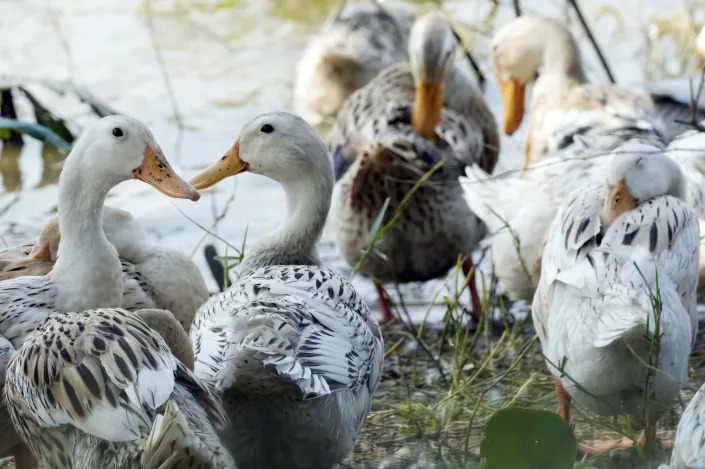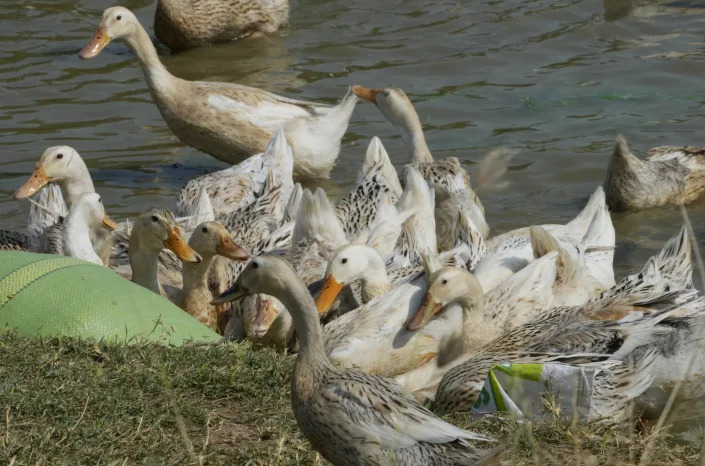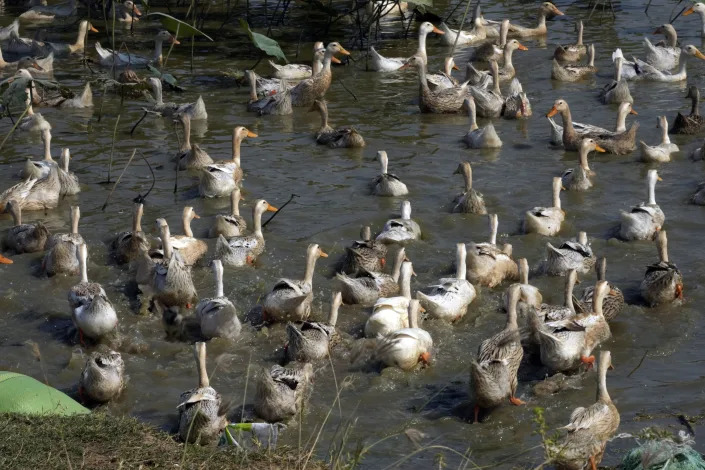An 11-year-old girl in Cambodia has died from bird flu in the country's first known human H5N1 infection since 2014, health officials said, Wednesday, Feb. 22, 2023.






Ducks swim in a pond in a Snoa village farm outside Phnom Penh, Cambodia, Thursday, Feb. 23, 2023.






Ducks swim in a pond in a Snoa village farm outside Phnom Penh, Cambodia, Thursday, Feb. 23, 2023.
(AP Photo/Heng Sinith)
SOPHENG CHEANG
Thu, February 23, 2023
PHNOM PENH, Cambodia (AP) — An 11-year-old girl in Cambodia has died from bird flu in the country's first known human H5N1 infection since 2014, health officials said.
Bird flu, also known as avian influenza, normally spreads in poultry and wasn’t deemed a threat to people until a 1997 outbreak among visitors to live poultry markets in Hong Kong. Most human cases worldwide have involved direct contact with infected poultry, but concerns have arisen recently about infections in a variety of mammals and the possibility the virus could evolve to spread more easily between people.
The girl from the rural southeastern province of Prey Veng became ill Feb. 16 and was sent to be treated at hospital in the capital, Phnom Penh. She was diagnosed Wednesday after suffering a fever up to 39 Celsius (102 Fahrenheit) with coughing and throat pain and died shortly afterward, the Health Ministry said in a statement Wednesday night.
Health officials have taken samples from a dead wild bird at a conservation area near the girl's home, the ministry said in another statement Thursday. It said teams in the area would also warn residents about touching dead and sick birds.
Cambodian Health Minister Mam Bunheng warned that bird flu poses an especially high risk to children who may be feeding or collecting eggs from domesticated poultry, playing with the birds or cleaning their cages.
Symptoms of H5N1 infection are similar to that of other flus, including cough, aches and fever, and in serious cases, patients can develop life-threatening pneumonia.
Cambodia had 56 human cases of H5N1 from 2003 through 2014 and 37 of them were fatal, according to the World Health Organization.
Globally, about 870 human infections and 457 deaths have been reported to the WHO in 21 countries. But the pace has slowed, and there have been about 170 infections and 50 deaths in the last seven years.
WHO Director-General Tedros Adhanom Ghebreyesus earlier this month expressed concern about avian influenza infections in mammals including minks, otters, foxes and sea lions.
“H5N1 has spread widely in wild birds and poultry for 25 years, but the recent spillover to mammals needs to be monitored closely,” he warned.
In January, a 9-year-old girl in Ecuador became the first reported case of human infection in Latin America and the Caribbean. She was treated with antiviral medicine.
Tedros said earlier this month that the WHO still assesses the risk from bird flu to humans as low.
“But we cannot assume that will remain the case, and we must prepare for any change in the status quo,” he said. He advised for people not to touch dead or sick wild animals and for countries to strengthen their surveillance of settings where people and animals interact.
SOPHENG CHEANG
Thu, February 23, 2023
PHNOM PENH, Cambodia (AP) — An 11-year-old girl in Cambodia has died from bird flu in the country's first known human H5N1 infection since 2014, health officials said.
Bird flu, also known as avian influenza, normally spreads in poultry and wasn’t deemed a threat to people until a 1997 outbreak among visitors to live poultry markets in Hong Kong. Most human cases worldwide have involved direct contact with infected poultry, but concerns have arisen recently about infections in a variety of mammals and the possibility the virus could evolve to spread more easily between people.
The girl from the rural southeastern province of Prey Veng became ill Feb. 16 and was sent to be treated at hospital in the capital, Phnom Penh. She was diagnosed Wednesday after suffering a fever up to 39 Celsius (102 Fahrenheit) with coughing and throat pain and died shortly afterward, the Health Ministry said in a statement Wednesday night.
Health officials have taken samples from a dead wild bird at a conservation area near the girl's home, the ministry said in another statement Thursday. It said teams in the area would also warn residents about touching dead and sick birds.
Cambodian Health Minister Mam Bunheng warned that bird flu poses an especially high risk to children who may be feeding or collecting eggs from domesticated poultry, playing with the birds or cleaning their cages.
Symptoms of H5N1 infection are similar to that of other flus, including cough, aches and fever, and in serious cases, patients can develop life-threatening pneumonia.
Cambodia had 56 human cases of H5N1 from 2003 through 2014 and 37 of them were fatal, according to the World Health Organization.
Globally, about 870 human infections and 457 deaths have been reported to the WHO in 21 countries. But the pace has slowed, and there have been about 170 infections and 50 deaths in the last seven years.
WHO Director-General Tedros Adhanom Ghebreyesus earlier this month expressed concern about avian influenza infections in mammals including minks, otters, foxes and sea lions.
“H5N1 has spread widely in wild birds and poultry for 25 years, but the recent spillover to mammals needs to be monitored closely,” he warned.
In January, a 9-year-old girl in Ecuador became the first reported case of human infection in Latin America and the Caribbean. She was treated with antiviral medicine.
Tedros said earlier this month that the WHO still assesses the risk from bird flu to humans as low.
“But we cannot assume that will remain the case, and we must prepare for any change in the status quo,” he said. He advised for people not to touch dead or sick wild animals and for countries to strengthen their surveillance of settings where people and animals interact.
WAIT, WHAT?!
Analysis-Why public health officials are not panicked about bird flu


New bird flu wave in France raises fears deadly virus here to stay
Thu, February 23, 2023
By Julie Steenhuysen
CHICAGO (Reuters) - A new strain of bird flu that transmits easily among wild birds has triggered an explosive spread into new corners of the globe, infecting and killing a variety of mammals species and raising fears of a pandemic more lethal than COVID-19.
But the very changes that have allowed the virus to infect wild birds so efficiently likely made it harder to infect human cells, leading disease experts told Reuters. Their views underpin global health officials' assessments that the current outbreak of H5N1 poses low risk to people.
The new strain, called H5N1 clade 2.3.4.4b, emerged in 2020 and has spread to many parts of Africa, Asia and Europe as well as North and South America, causing unprecedented numbers of deaths among wild birds and domestic poultry.
The virus has also infected mammals ranging from foxes and grizzly bears to seals and sea lions, likely from feeding on diseased birds.
Unlike earlier outbreaks, this subtype of H5N1 is not causing significant disease in people. So far, only about a half dozen cases have been reported to the World Health Organization (WHO) in people who had close contact with infected birds, and most of those have been mild.
"We think the risk to the public is low," Dr. Timothy Uyeki, chief medical officer of the U.S. Center for Disease Control and Prevention's (CDC) Influenza Division, said in an interview. The WHO expressed a similar view in an assessment earlier this month.
The way this virus enters and infects cells is one reason for the muted concern, flu experts told Reuters. They say the attributes that have made this virus thrive in wild birds likely make it less infectious to people.
"It's clear that this is a very, very successful virus for birds, and that almost excludes it from being a very, very successful virus in mammals," said Richard Webby, director of the WHO Collaborating Center for Studies on the Ecology of Influenza in Animals and Birds at St. Jude Children's Hospital.
Experts see the spillover into mammals as an early warning sign to step up virus surveillance rather than a signal of a new pandemic.
"Everybody take a breath," Dr. Michael Osterholm, an infectious disease expert at the University of Minnesota who has tracked H5N1 since it first emerged in 1997, said of those sounding alarm bells.
WHAT ABOUT THE MINKS?
What raised concern among virologists was a study published in January in the medical journal Eurosurveillance showing potential mammal-to-mammal transmission of the virus on a mink farm in Spain.
"It is highly plausible that a virus capable of mink-to-mink transmission is capable of human-to-human transmission," Michelle Wille, an expert in the dynamics of wild bird viruses at the University of Sydney, said in an email.
That is a scenario that disease experts have been warning about for decades. Mink share many attributes with ferrets, an animal often used in flu experiments because of their similarity to humans.
Although the exact changes required for a bird flu virus to become easily transmissible in people are not known, a pair of landmark studies done a decade ago offer some clues.
Using so-called gain of function experiments, scientists intentionally altered the H5N1 virus to make it transmissible in ferrets and found that as few as five highly specific mutations were required.
Most of the mammalian cases so far have had only one of these mutations - in a gene called PB2 - which was present in the mink. Webby said the virus can make that change easily.
What has not changed, even in mink, is that the virus still prefers to bind to avian-type receptors to enter and infect cells. Mink have both avian and human-type receptors, but avian receptors are scarce in humans and located deep in the lungs.
Human flu viruses typically bind to receptors found in the upper respiratory tract.
"We know that avian viruses can occasionally affect people, but it takes what appears to be lots and lots of contact with birds," said James Lowe, a professor of veterinary clinical medicine at the University of Illinois.
According to the CDC's Uyeki, studies of the H5N1 genetic sequences in the mink outbreak "do not indicate any changes that suggest increased ability to infect the upper respiratory tract of humans."
That change is a must if a bird flu virus is to spread easily in people.
"The saving grace for humans right now is it seems that it's really, really difficult for this virus to switch receptor preference," Webby said.
None of the experts discounted the possibility that H5N1 or another avian flu virus could mutate and spark a pandemic, and many believe the world has not seen its last flu pandemic.
"Should we keep an eyeball out for this? Yes," Lowe said. "Should we lose our mind over it? Probably not."
(Reporting by Julie Steenhuysen; Editing by Bill Berkrot)


New bird flu wave in France raises fears deadly virus here to stay
Thu, February 23, 2023
By Julie Steenhuysen
CHICAGO (Reuters) - A new strain of bird flu that transmits easily among wild birds has triggered an explosive spread into new corners of the globe, infecting and killing a variety of mammals species and raising fears of a pandemic more lethal than COVID-19.
But the very changes that have allowed the virus to infect wild birds so efficiently likely made it harder to infect human cells, leading disease experts told Reuters. Their views underpin global health officials' assessments that the current outbreak of H5N1 poses low risk to people.
The new strain, called H5N1 clade 2.3.4.4b, emerged in 2020 and has spread to many parts of Africa, Asia and Europe as well as North and South America, causing unprecedented numbers of deaths among wild birds and domestic poultry.
The virus has also infected mammals ranging from foxes and grizzly bears to seals and sea lions, likely from feeding on diseased birds.
Unlike earlier outbreaks, this subtype of H5N1 is not causing significant disease in people. So far, only about a half dozen cases have been reported to the World Health Organization (WHO) in people who had close contact with infected birds, and most of those have been mild.
"We think the risk to the public is low," Dr. Timothy Uyeki, chief medical officer of the U.S. Center for Disease Control and Prevention's (CDC) Influenza Division, said in an interview. The WHO expressed a similar view in an assessment earlier this month.
The way this virus enters and infects cells is one reason for the muted concern, flu experts told Reuters. They say the attributes that have made this virus thrive in wild birds likely make it less infectious to people.
"It's clear that this is a very, very successful virus for birds, and that almost excludes it from being a very, very successful virus in mammals," said Richard Webby, director of the WHO Collaborating Center for Studies on the Ecology of Influenza in Animals and Birds at St. Jude Children's Hospital.
Experts see the spillover into mammals as an early warning sign to step up virus surveillance rather than a signal of a new pandemic.
"Everybody take a breath," Dr. Michael Osterholm, an infectious disease expert at the University of Minnesota who has tracked H5N1 since it first emerged in 1997, said of those sounding alarm bells.
WHAT ABOUT THE MINKS?
What raised concern among virologists was a study published in January in the medical journal Eurosurveillance showing potential mammal-to-mammal transmission of the virus on a mink farm in Spain.
"It is highly plausible that a virus capable of mink-to-mink transmission is capable of human-to-human transmission," Michelle Wille, an expert in the dynamics of wild bird viruses at the University of Sydney, said in an email.
That is a scenario that disease experts have been warning about for decades. Mink share many attributes with ferrets, an animal often used in flu experiments because of their similarity to humans.
Although the exact changes required for a bird flu virus to become easily transmissible in people are not known, a pair of landmark studies done a decade ago offer some clues.
Using so-called gain of function experiments, scientists intentionally altered the H5N1 virus to make it transmissible in ferrets and found that as few as five highly specific mutations were required.
Most of the mammalian cases so far have had only one of these mutations - in a gene called PB2 - which was present in the mink. Webby said the virus can make that change easily.
What has not changed, even in mink, is that the virus still prefers to bind to avian-type receptors to enter and infect cells. Mink have both avian and human-type receptors, but avian receptors are scarce in humans and located deep in the lungs.
Human flu viruses typically bind to receptors found in the upper respiratory tract.
"We know that avian viruses can occasionally affect people, but it takes what appears to be lots and lots of contact with birds," said James Lowe, a professor of veterinary clinical medicine at the University of Illinois.
According to the CDC's Uyeki, studies of the H5N1 genetic sequences in the mink outbreak "do not indicate any changes that suggest increased ability to infect the upper respiratory tract of humans."
That change is a must if a bird flu virus is to spread easily in people.
"The saving grace for humans right now is it seems that it's really, really difficult for this virus to switch receptor preference," Webby said.
None of the experts discounted the possibility that H5N1 or another avian flu virus could mutate and spark a pandemic, and many believe the world has not seen its last flu pandemic.
"Should we keep an eyeball out for this? Yes," Lowe said. "Should we lose our mind over it? Probably not."
(Reporting by Julie Steenhuysen; Editing by Bill Berkrot)
No comments:
Post a Comment